Types of zinnia: 16 uplifting varieties to grow on your plot
Grow these 16 types of zinnia and bring a vibrant Mexican wave of zingy summer color to your garden
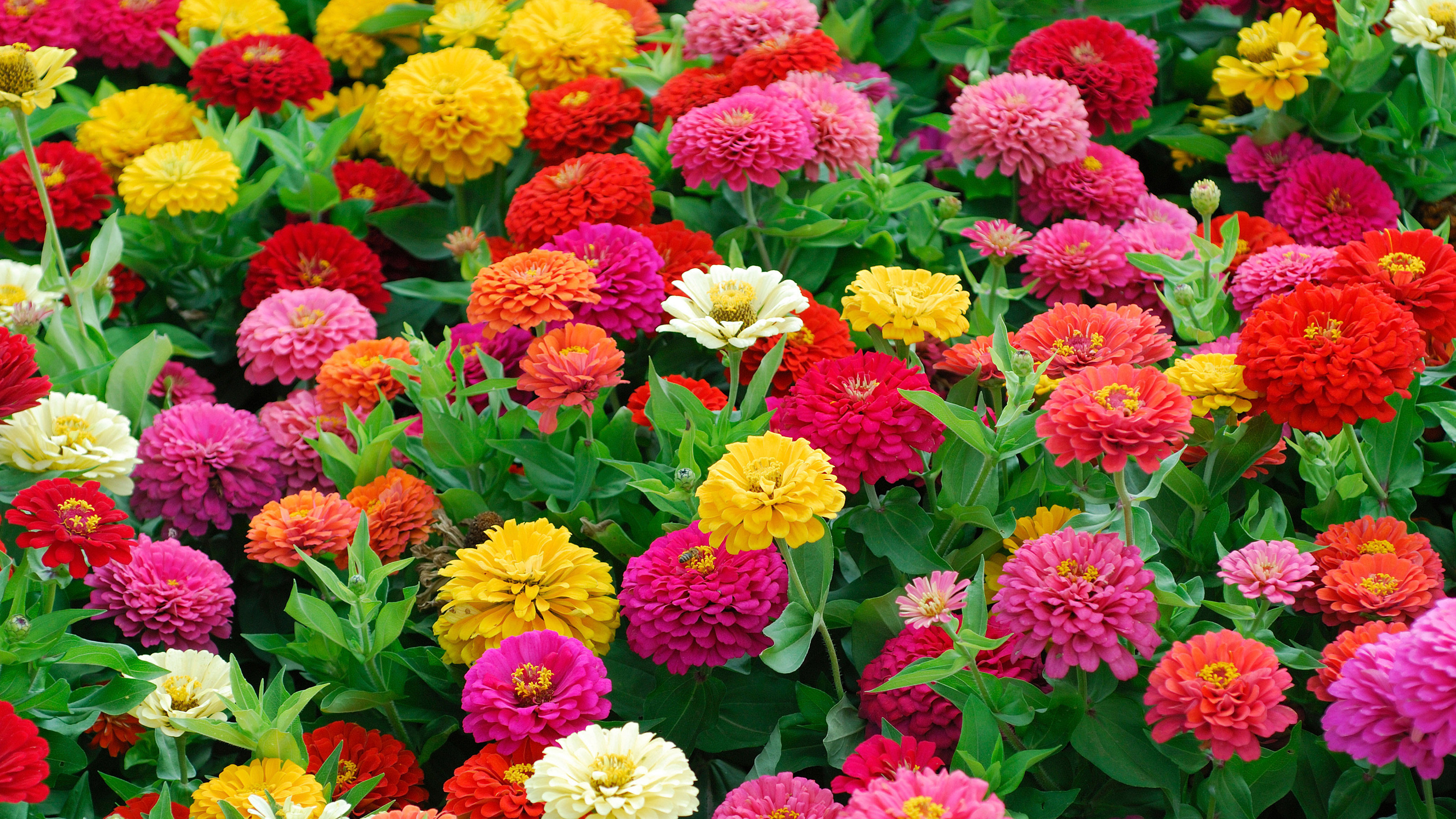

All types of zinnia have one thing in common: they add instant dazzle to garden displays. Put simply, these Mexican daisies are nothing if not bright. Tall or short, long stemmed or bushy, single or double – for borders, cut flowers, edging or containers – these brilliantly colored summer-flowering daisies create vivid (even luminous) arrangements.
Zinnia varieties vary in shape, from daisies to dainty stars to anemone centers to blowsy like chrysanthemums. They may sometimes be like neat buttons or stars; at other times, big and bold. They are half-hardy annual flowers. Sown in spring, they bloom all summer, adding real zing to dynamic flowerbed ideas – and they are super-easy to grow.
The ‘half-hardy’ part means they are happy to grow outside. These warm-season annual flowerers will not take frost, though, so are best raised under cover and planted out, or sown out after the last frosts. When planting out, just take care not to firm young plants too hard when planting, and don’t overwater. After that, they need minimal care.
Tall varieties are ideal for cutting and for bold groups in a sunny border. They need support, so add canes around a clump or along a row, looped with twine. For edging, low-growing zinnia varieties in a mix of colors are ideal. Place in front of plants or groups in single shades, or shrubs that flower at a different time of year. For containers, single colors work best, and choose taller companions in matching shades. Or use a mixture and give plants the tub to themselves.
Here we show you some of the brightest, most cheerful and dynamic types of zinnia to try to add an instant color boost to containers, borders and cutting gardens – for a gorgeous and lively summer-long display.
These 16 types of zinnia create easygoing displays all summer long
Sunshine-loving zinnia varieties are typically vibrant with an intense summer palette. Recent breeds have broadened the range to include softer pastels, creams and whites, some with mixed tones to give garden borders extra depth and detail. Petals can be daisy based, dahlia styled and cactus flowered. You can choose from short and spreading types of zinnia, as well as taller types that reach several feet high. All are easy to grow and bloom quickly for extensive summer bursts of interest.
1. ‘Benary's Giant Salmon Rose’ AGM
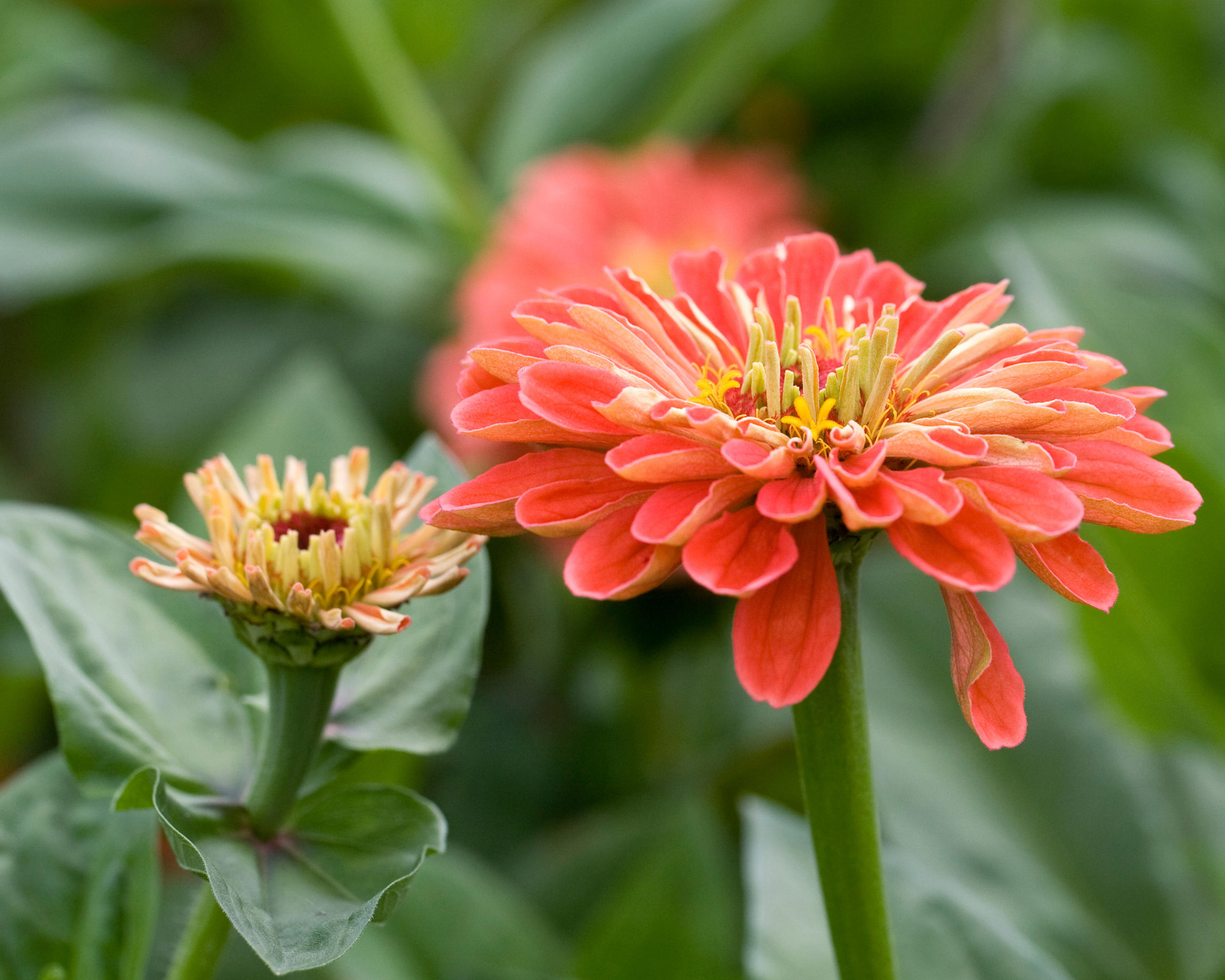
Zinnia ‘Benary’s Giant Salmon Rose’
- Hardiness: USDA 2-11 (UK H2)
- Height: 3-4ft (0.9-1.2m)
- Best for: sunny borders
‘Benary's Giant Salmon Rose’ is a tall and well-branched zinnia variety that works particularly well in borders and cutting gardens. Its 4-5in (10-12cm) fully double flowers are a soft, slightly antique salmon pink with a golden eye.
These types of zinnia are happiest in full sun and fertile, well-drained soil. They need support and appreciate shelter. They are especially lovely grouped with Elaeagnus ‘Quicksilver’, Rose ‘Gertrude Jekyll’ (and similar shrub types of roses), plus other ‘Benary’s Giant’ zinnias.
2. Zinnia elegans ‘Envy’ AGM
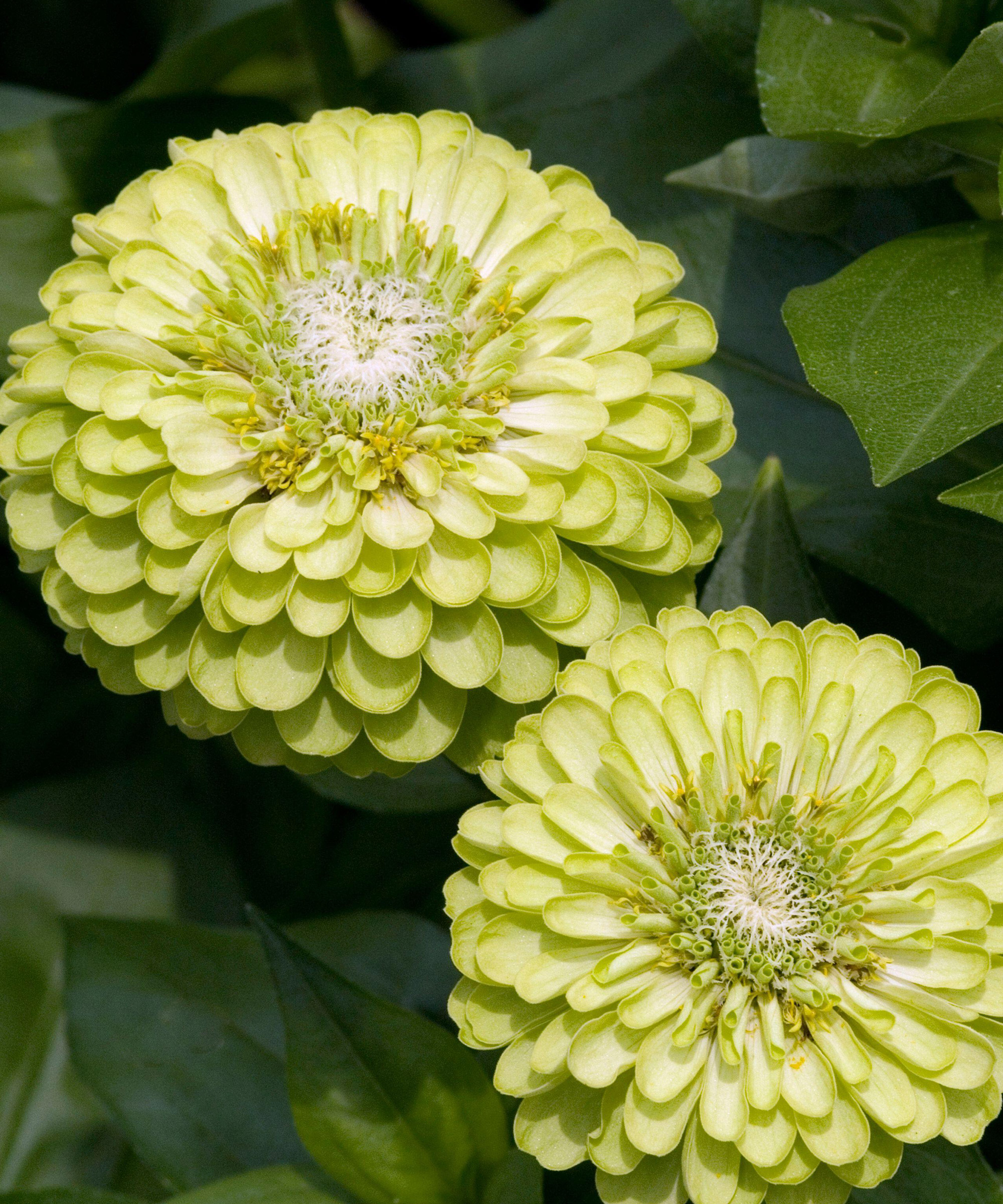
Zinnia elegans ‘Envy’
- Hardiness: USDA 2-11 (UK H2)
- Height: 3-4ft (0.9-1.2m)
- Best for: dark-flower groups
If you like green flowers, you’ll love ‘Envy’. Green-flowered zinnias are always popular, especially in the fully double flowered style. If ‘Envy’ is not available, we can recommend ‘Benary’s Giant Lime’.
These types of zinnia work beautifully with Canna ‘Wyoming’, Dahlia ‘Karma Choc’ and other large-flowered zinnias. Grow in border clumps, or in a row in full sun solely for cutting. Protect from gales with shelter or supports, and deadhead regularly if not cut.
3. Zinnia ‘Lilliput Mix’
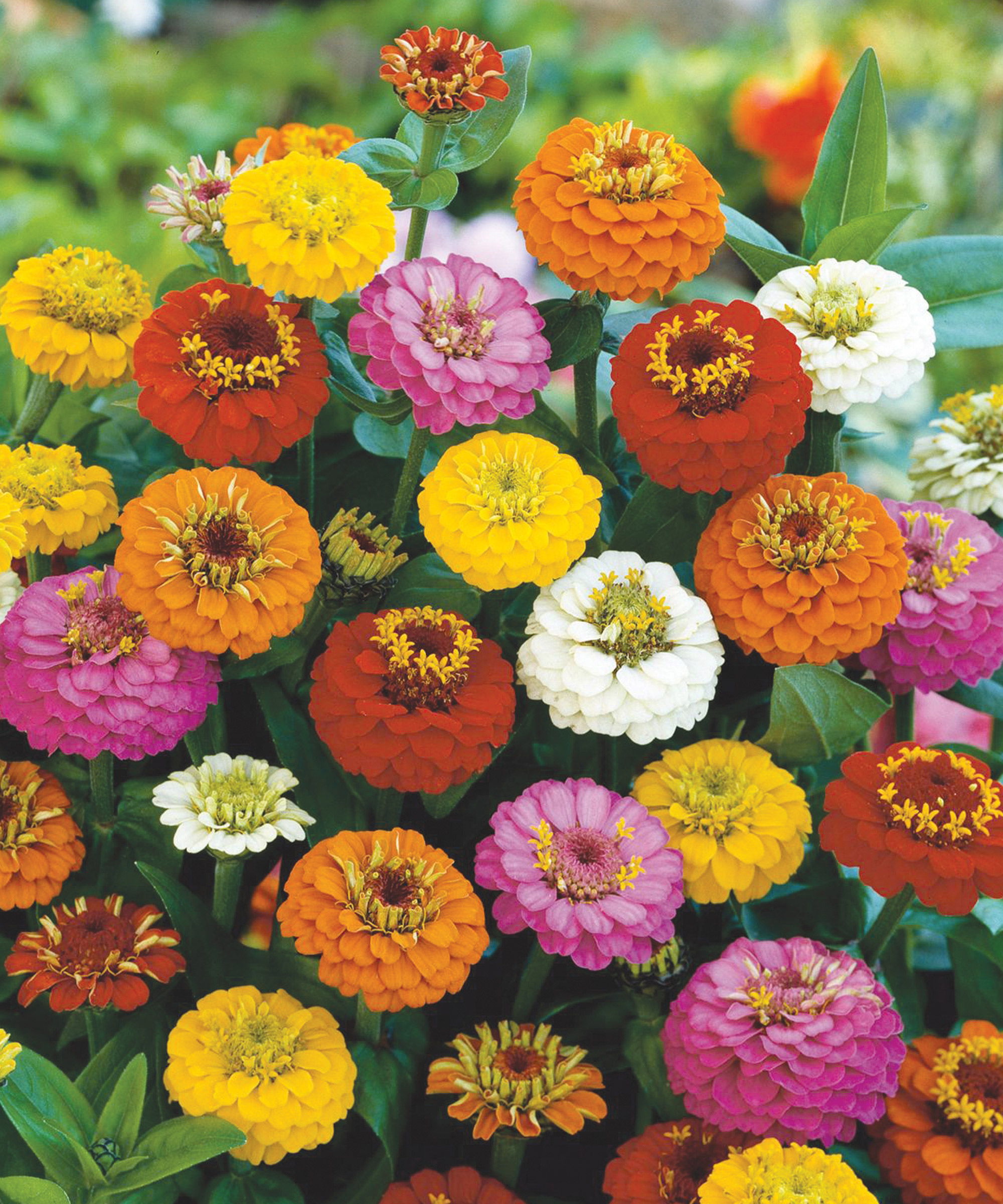
Zinnia ‘Lilliput Mix’
- Hardiness: USDA 2-11 (UK H2)
- Height: 18-24in (45-60cm)
- Best for: hiding stems of tall flowers
‘Lilliput Mix’ flowers are bushy, mid-size types of zinnia. Their 2in (5cm) double flowers come in half-a-dozen golden-eyed shades, from rich reds to bright whites. If you are looking for south-facing garden inspiration, these zinnias thrive in full sun in any reasonable soil.
Ideal as a small cut flower for mixed posies, they also work well planted so as to hide the stems of taller varieties. Excellent partnered with the Dahlia Mystic Series, Ipomoea ‘Sweet Caroline Sweetheart Lime’ and Lobelia ‘Sapphire’.
4. Zinnia Oklahoma Series AGM
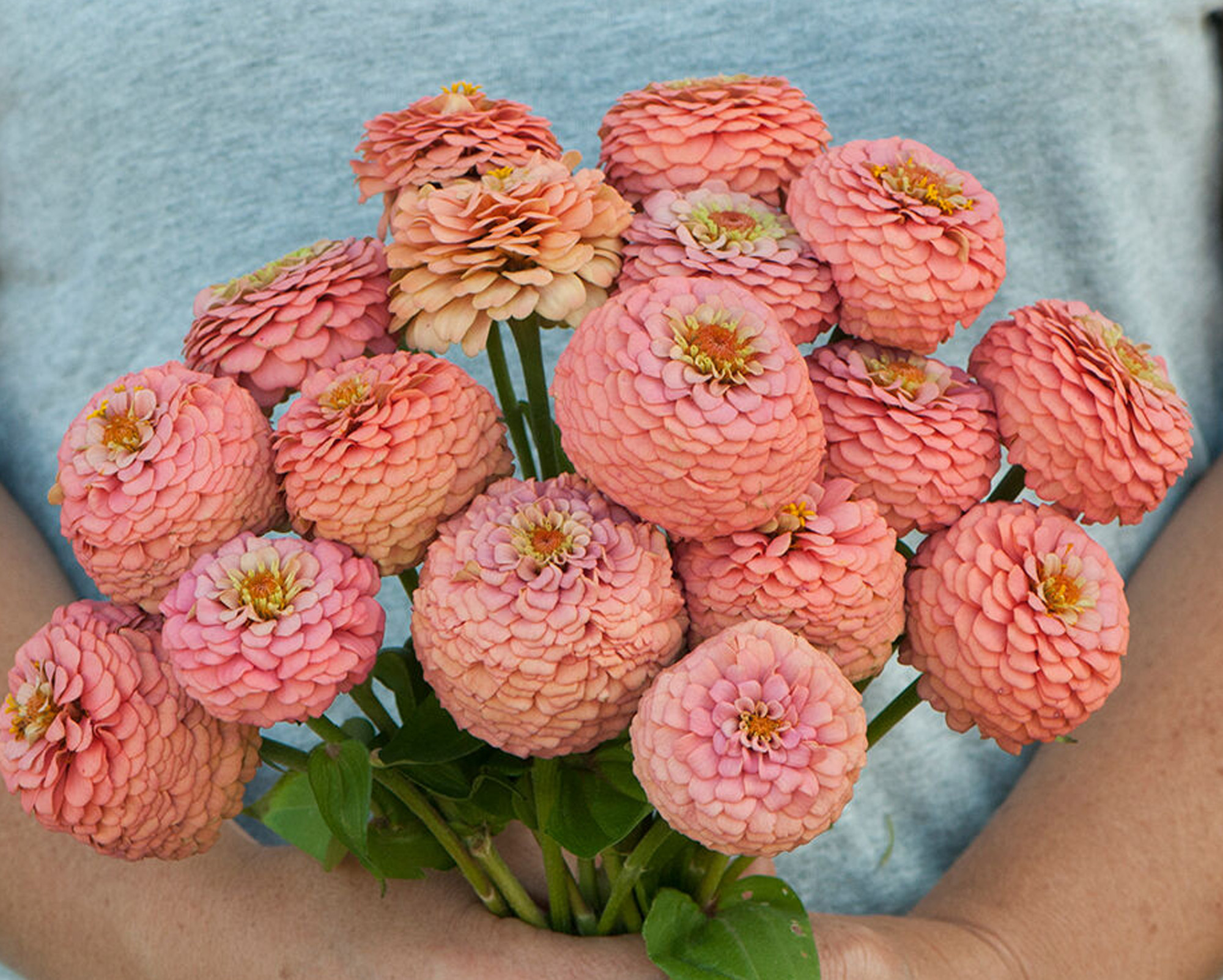
Zinnia ‘Oklahoma Series’
- Hardiness: USDA 2-11 (UK H2)
- Height: 30-40in (75cm-1m)
- Best for: wind resistance
The Oklahoma Series are fine-looking types of zinnia with small double and semi-double flowers in six colors. These blooms are 1.5-2in (2-2.5cm) across, and the flowers combine tall growth with good branching. Its smaller flowers stand up to wind better than larger-flowered varieties.
They grow best in full sun and well-drained soil, and resist mildew better than many zinnias. For those who love to grow begonias, these zinnias work well with Begonia ‘Glowing Embers’, as well as Carex ‘Everillo’ and Physocarpus ‘Diablo’.
5. Zinnia ‘Pop Art Gold and Red’
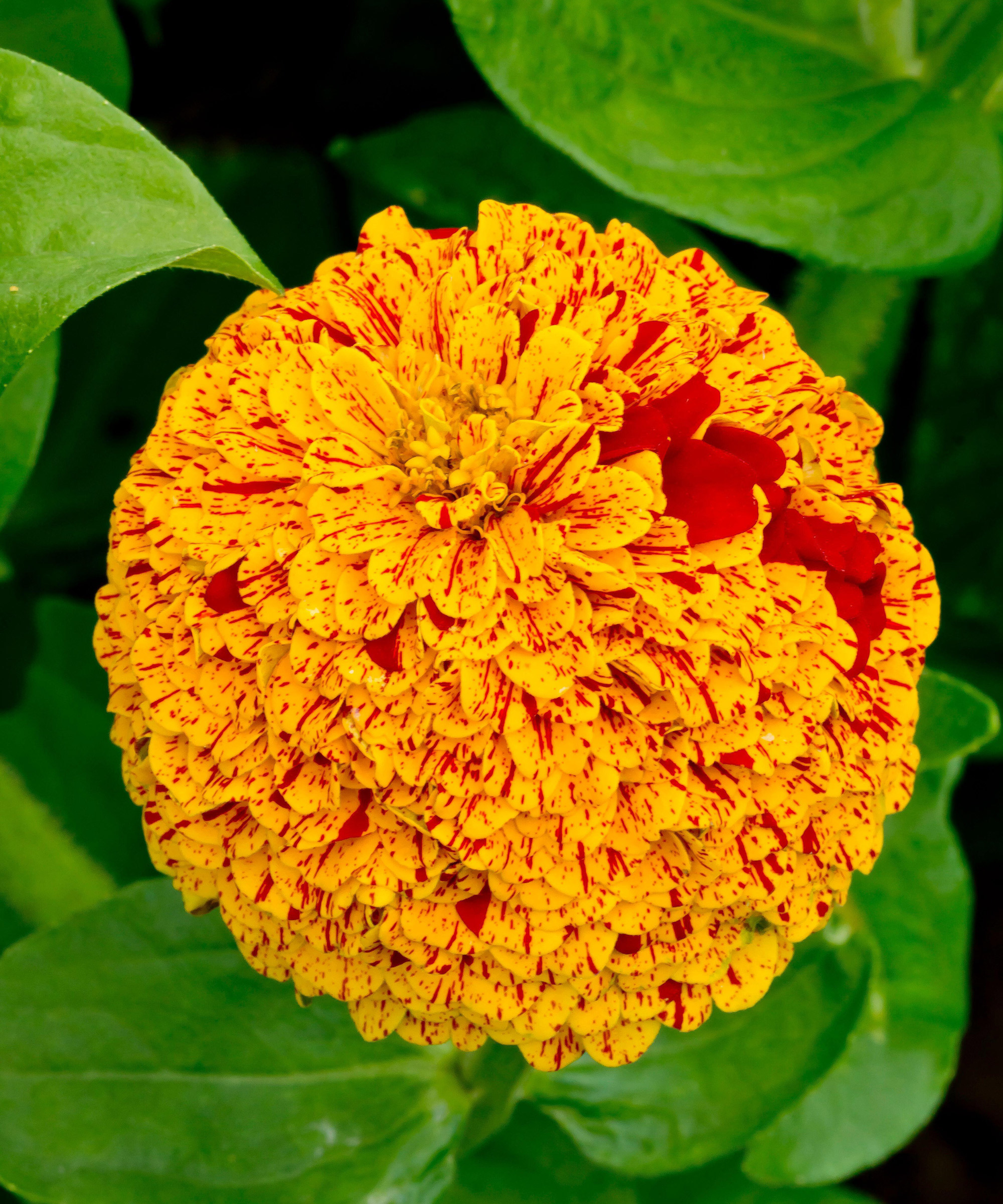
Zinnia ‘Pop Art Gold and Red’
- Hardiness: USDA 2-11 (UK H2)
- Height: 2-3ft (60-90cm)
- Best for: unsupported planting
For those of you that love yellow flowers, ‘Pop Art Gold and Red’ is a real sparkler! However, it’s 50-50 whether you’ll end up with golden flowers that have scarlet flecks, or raspberry-speckled whites! These types of zinnia are shorter than many and less likely to need staking
These bright and bold border beauties adore full sunshine, and prefer fertile well-drained soil. For maximum impact and color accents, plant these zinnias with ‘Benary’s Giant Golden Yellow', ‘Benary’s Giant Scarlet’ and ‘Benary’s Giant White’.
6. Zinnia ‘Purple Prince’ AGM
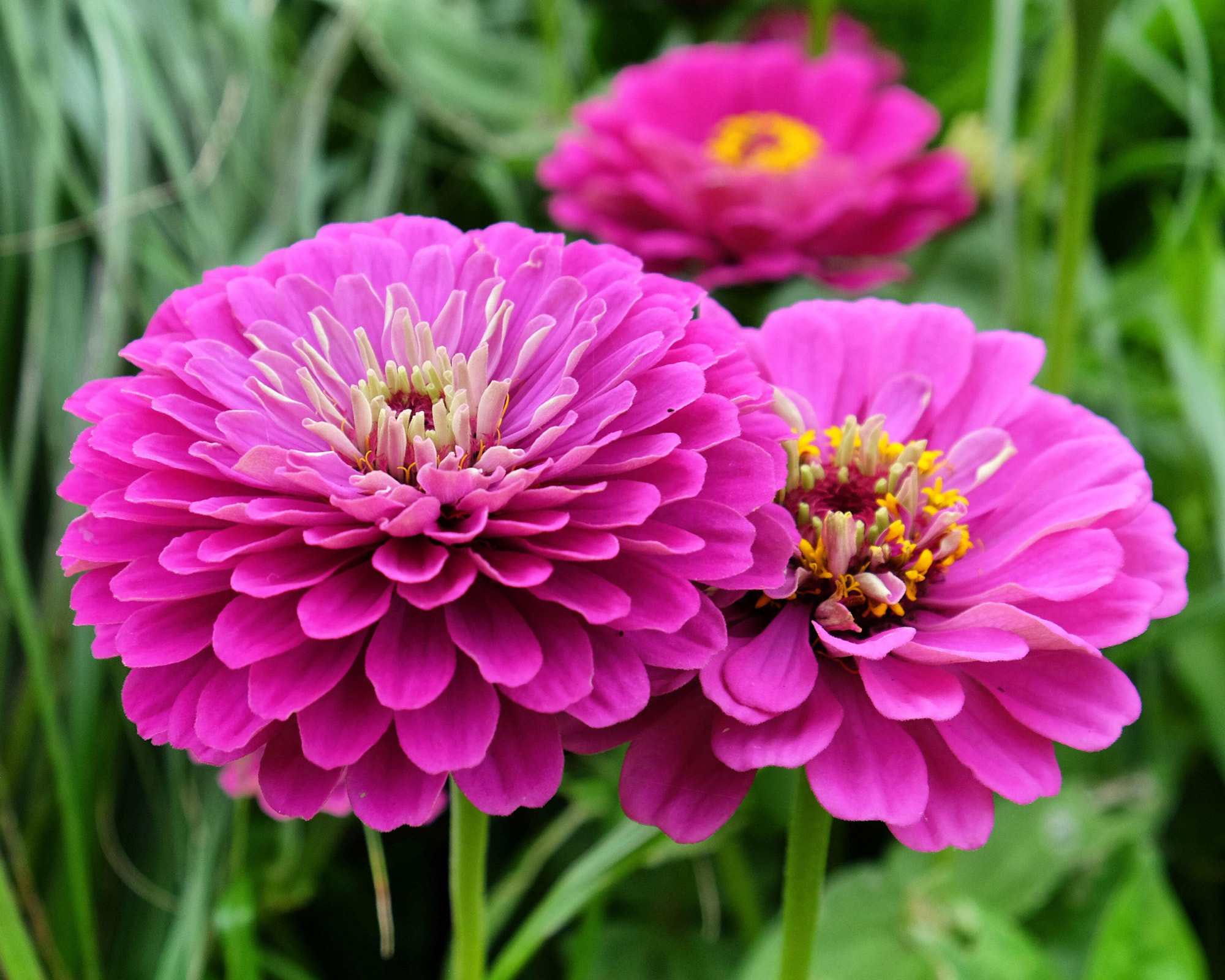
Zinnia ‘Purple Prince’
- Hardiness: USDA 2-11 (UK H2)
- Height: 3-4ft (90cm-1.2mm)
- Best for: cutting and mixed borders
There’s something about these types of zinnia that is evocative of slightly squishy pompoms. If you love to grow those types of dahlias with tight floral cushions, ‘Purple Prince’ is for you. To set off its stunning double flowers in vibrant purple, the central petals are white on the backs, providing bright sparkles in the heart of each 4in (10cm) bloom.
These blooms are ideal for a cutting garden and showcasing in mixed borders. Like all tall zinnia varieties, this one needs sunshine, rich, well-drained soil and thoughtful support. For the ultimate intensity, plant with Coleus ‘Lime Delight’, Helichrysum petiolare and Verbena ‘Lollipop’.
7. Zinnia ‘Queen Red Lime’ AGM
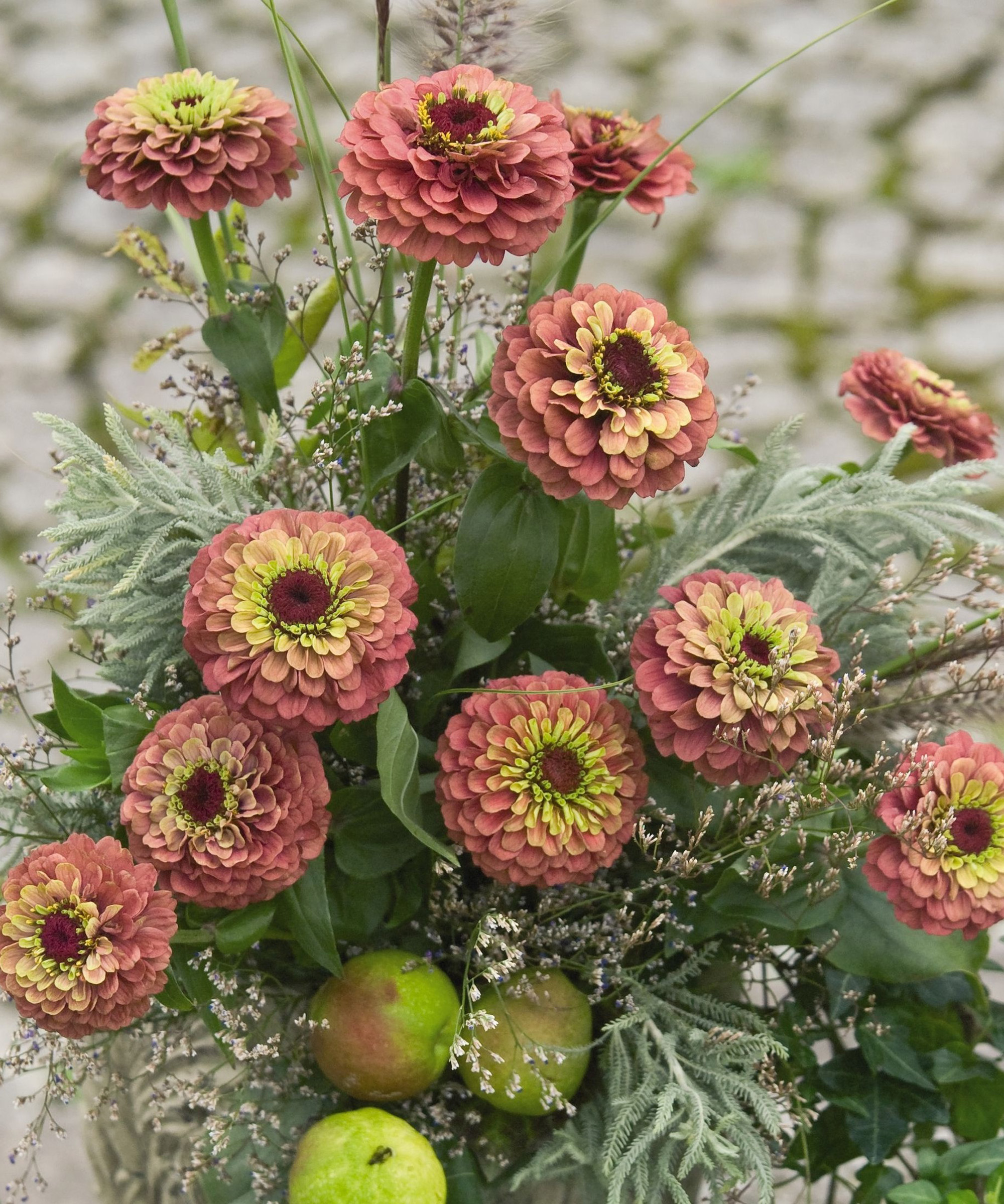
Zinnia ‘Queen Red Lime’
- Hardiness: USDA 2-11 (UK H2)
- Height: 30-40in (75cm-1m)
- Best for: unusual color
These types of zinnia are fully double flowers with an extraordinary pattern of petals. They begin deep red in the center, turning to lime green, then opening to limey pink and closing with purplish red. All day sunshine with rich but well-drained soil is ideal for ‘Queen Red Lime’.
Grow for cutting, and give these zinnia varieties pride of place in your garden borders so you can appreciate their delightful 3in (9cm) flowers close up. If you know how to grow salvias, these zinnias partner well with Salvia ‘Love and Wishes’ as well as Echinacea ‘Green Twister’.
8. Zinnia ‘Whirligig Mixed’
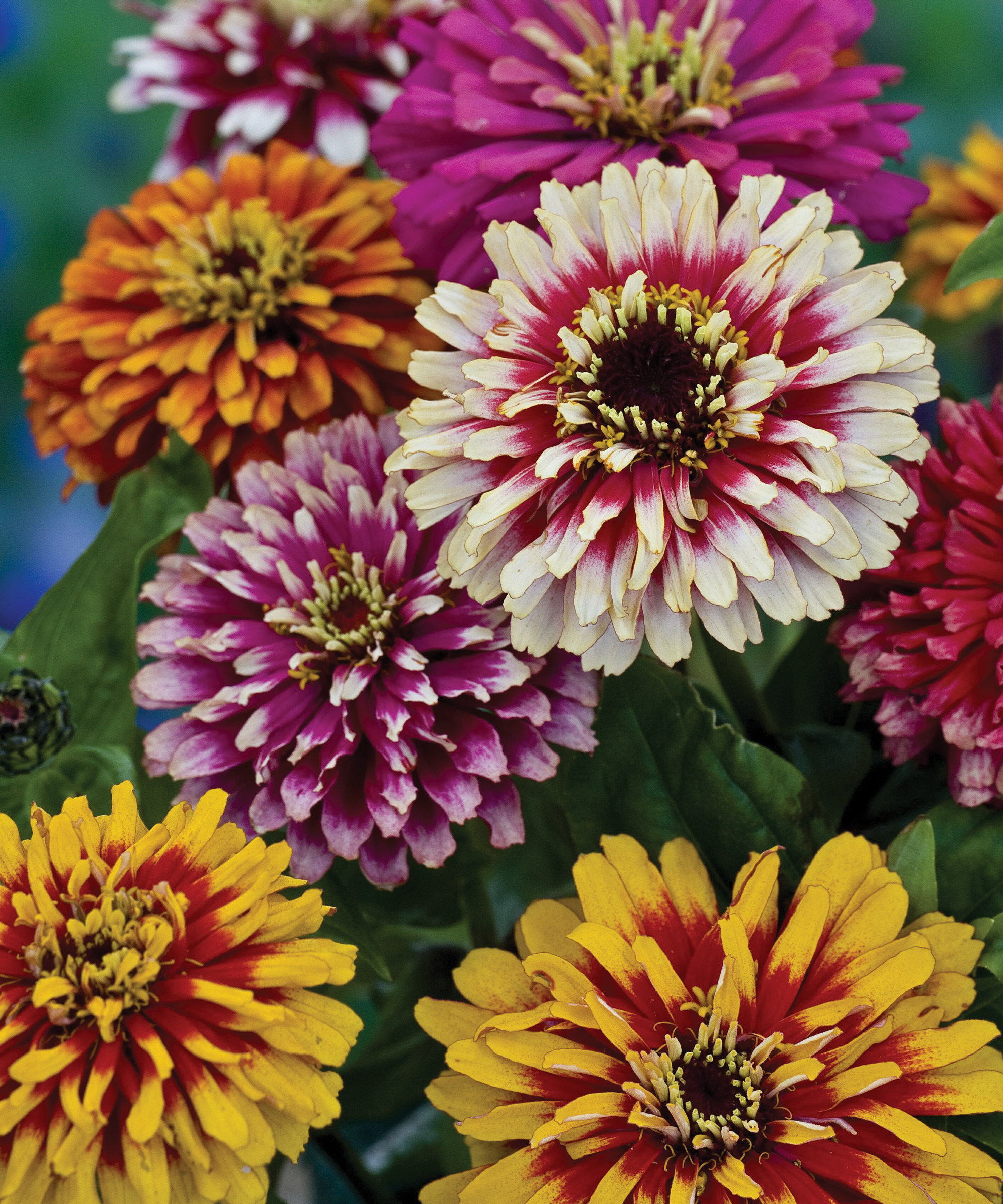
Zinnia ‘Whirligig Mixed’
- Hardiness: USDA 2-11 (UK H2)
- Height: 18-20in (45-50cm)
- Best for: foliage pairings
If you’re after a particularly cheerful blend of flowers in a variety of brightly bi-colored shades, look no further than ‘Whirligig Mixed’. Its petals are usually darker at the base and paler at the tips. As with other types of zinnia, the usual sunshine and good drainage rules apply.
To help these zinnias stand out and make the most of their dazzling colors, grow with the best foliage plants or structural grasses. Or for an especially eye-catching combo, partner them with Coleus ‘Kong Red’, Helichrysum petiolare ‘Limelight’ and Pennisetum setaceum ‘Rubrum’.
9. Zinnia ‘Zinderella Lilac’
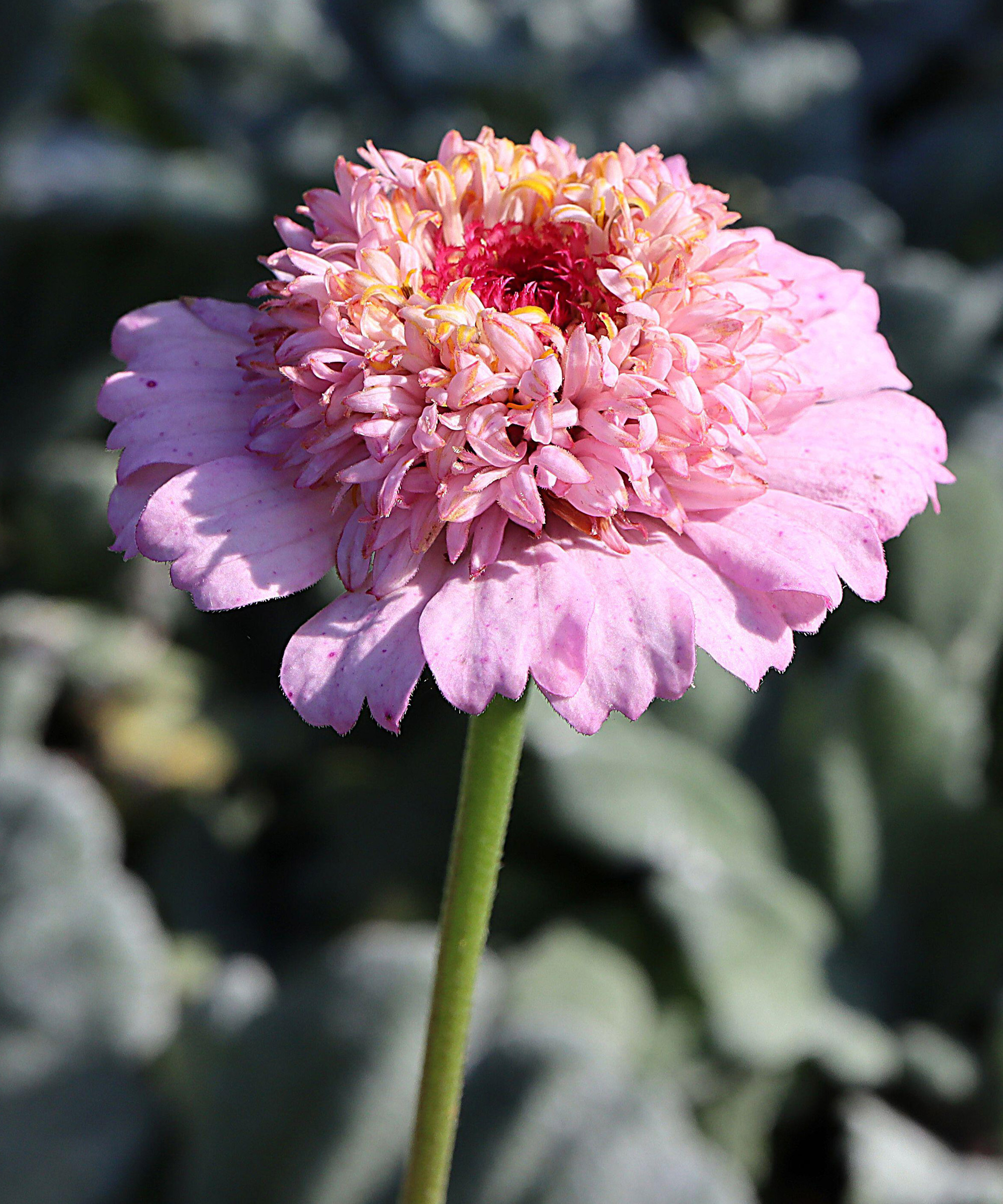
Zinnia ‘Zinderella Lilac’
- Hardiness: USDA 2-11 (UK H2)
- Height: 28-36in (70-90cm)
- Best for: mixed textures
‘Zinderella’ flowers look like scabious and come in breathtaking pastel shades, including peach and this pale purple charmer. For those of you who love purple flowers, this is a beguiling pinky purple zinnia, with a raised crown in the center of each flower to enhance the impact.
When growing these types of zinnia, pinch out at 18in (45cm) and support with pea-and-bean netting (fixed horizontally) to encourage the best blooms. These zinnia varieties work well in clumps between roses. Also lovely partnered with other zinnias in the ‘Zinderella’ series, plus Rose ‘Graham Thomas’ and Weigela ‘Alexandra’.
10. Zinnia ‘Zahara Double Salmon Rose’ AGM
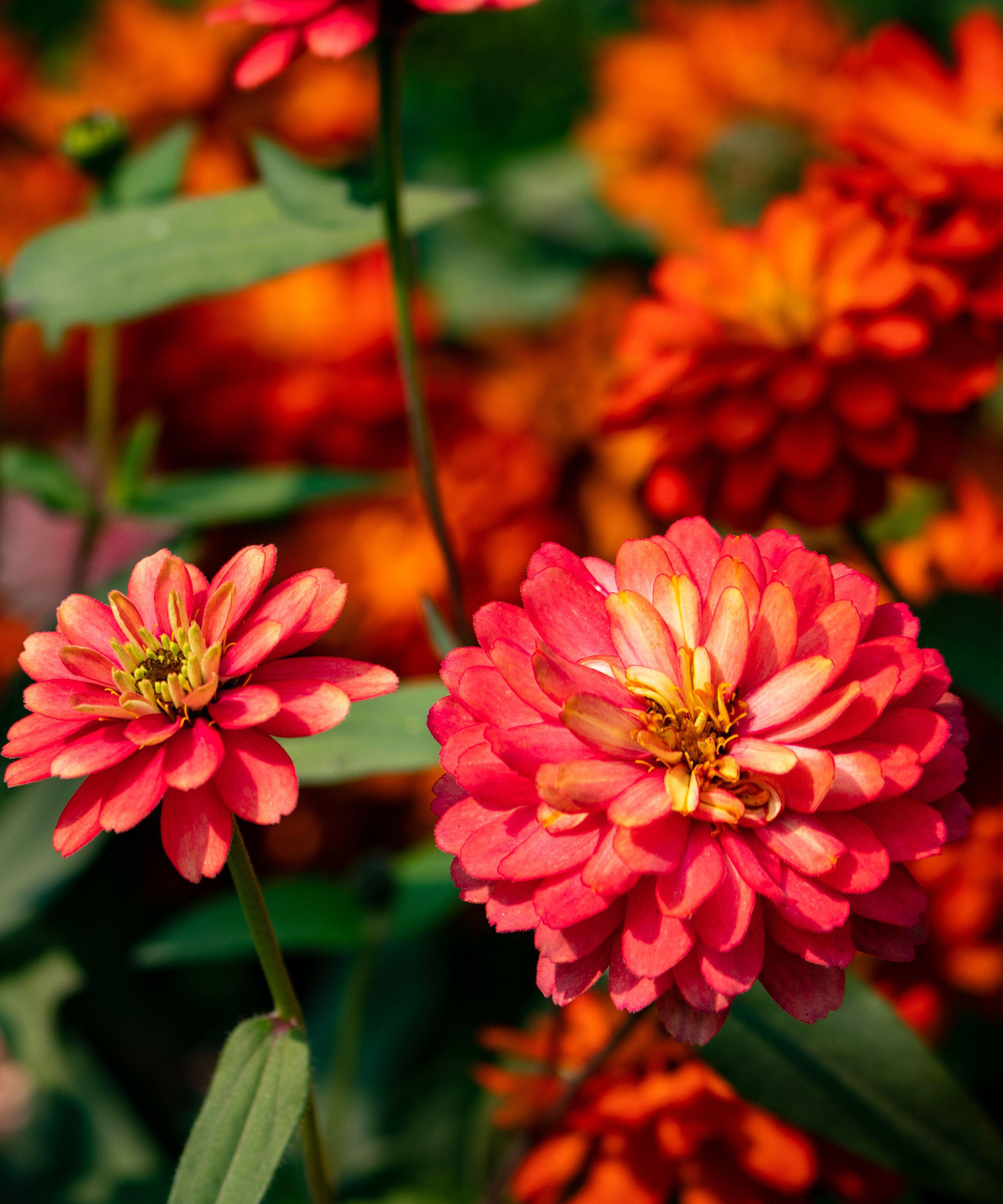
Zinnia ‘Zahara Double Salmon Rose’
- Hardiness: USDA 2-11 (UK H2)
- Height: 16-20in (40-50cm)
- Best for: container gardening
Covered in neat, fully double flowers in rosy coral, the tightly paced petals of these ‘Zahara’ zinnias create long-lasting flowers on nicely rounded plants. These types of zinnias, which are disease-resistant and consistently prolific, are lovely grown for small posies.
Thanks to their compact habit and prolific nature, they also make ideal specimens for dainty container gardening ideas and mixed planters and will thrive on a sunny patio. Gorgeous partnered with Alyssum ‘Snow Crystals’, Cineraria ‘Silverdust’ and Lobelia ‘Blue Cascade’.
11. Zinnia ‘Profusion Orange’ AGM
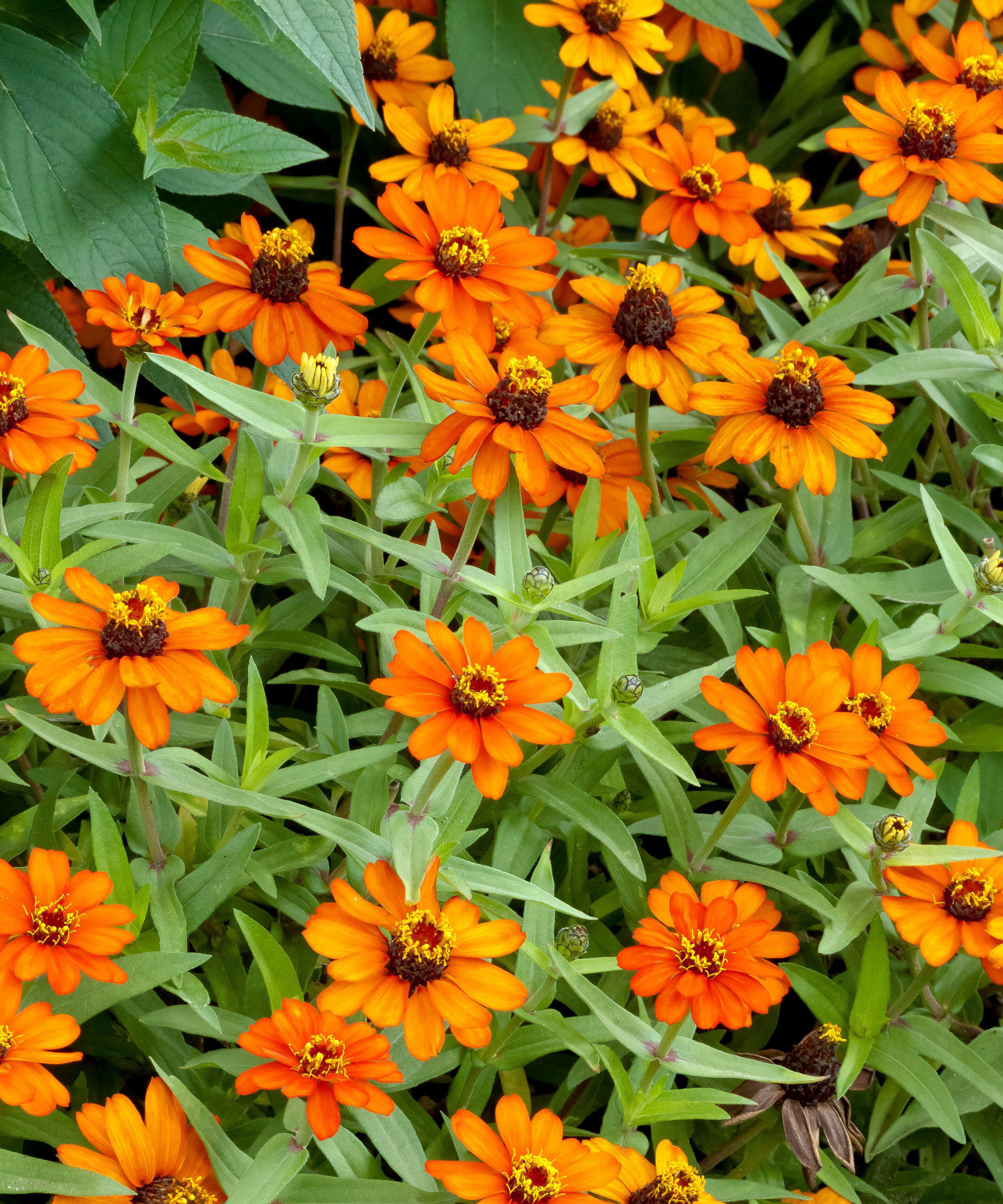
Zinnia ‘Profusion Orange’
- Hardiness: USDA 2-11 (UK H2)
- Height: 14-18in (35-45cm)
- Best for: window boxes
These are some of the most zingy types of zinnia you can grow. Their low, bushy plants will be covered all summer in flat, semi-double flowers in two-tone orange, all set against slender foliage. Grow in a sunny situation at the edge of large planters, or in troughs or window boxes.
If you have a hankering for the best black plants, ‘Profusion Orange’ provides a delightful contrast with the likes of Ipomoea ‘Solar Power Black Heart’. These citrusy blooms also partner well with Coleus ‘Chocolate Mint’ and Gaillardia ‘Fanfare’.
12. Zinnia ‘Zahara Starlight Rose’
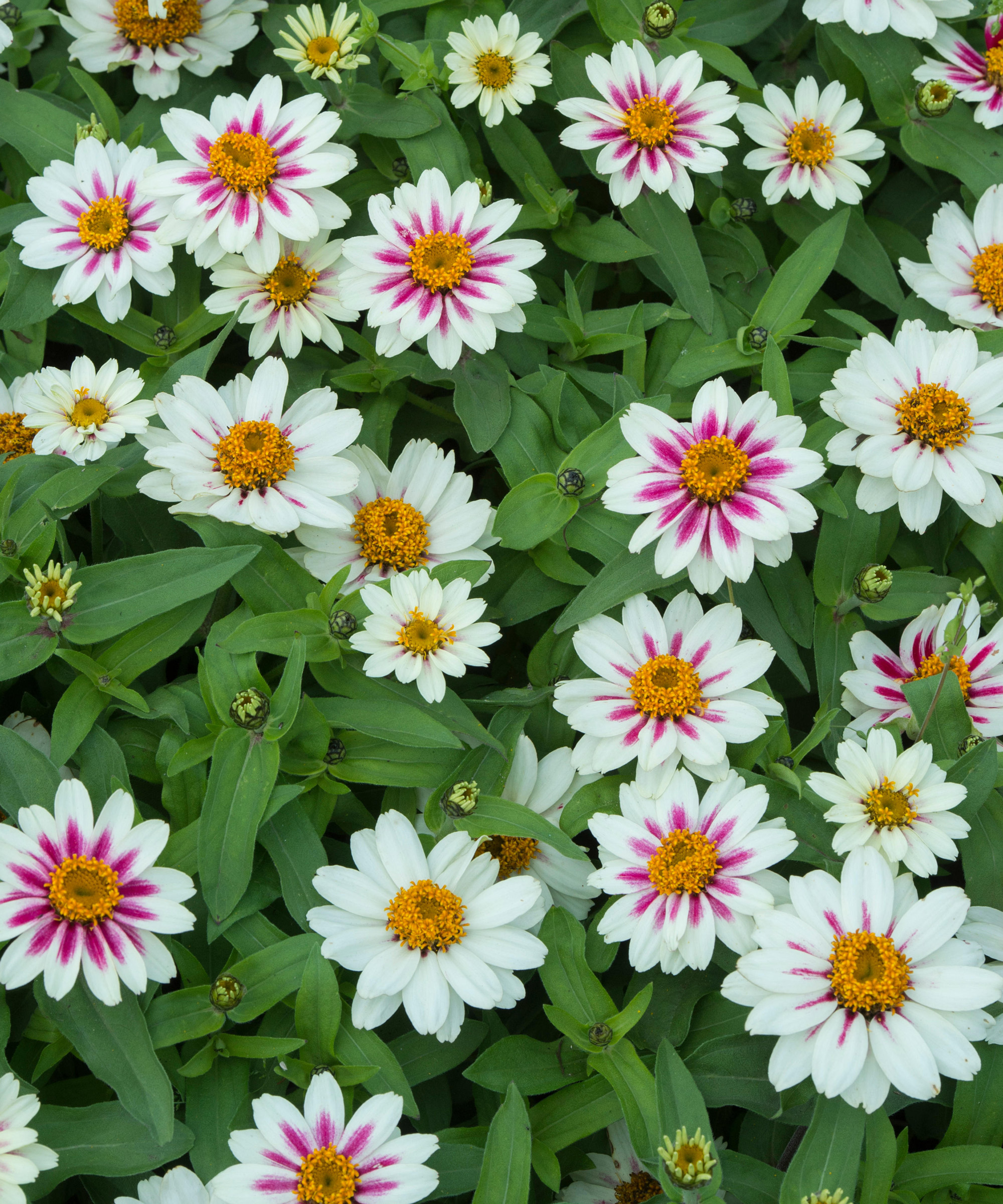
Zinnia ‘Zahara Starlight Rose’
- Hardiness: USDA 2-11 (UK H2)
- Height: 2-18in (30-45cm)
- Best for: planters
If you’re on a quest for the best patio plants for your garden, these charming blooms are some of the most eye-catching types of zinnia, as well as some of the most prolific. ‘Zahara Starlight Rose’ is a popular shorter zinnia; it is disease resistant and sure to thrive in sunny spots.
With bright white petals on starry flowers flashed in bright raspberry red, these zinnias are lovely grown in planters with the likes of Petunia ‘Daddy Blue’ and Salvia ‘Seascape’. This is also a powerful specimen bloomer if grown in a blue-glazed planter. Stand planters on pot feet to ensure good drainage.
13. Zinnia ‘Aztec Sunset Improved'
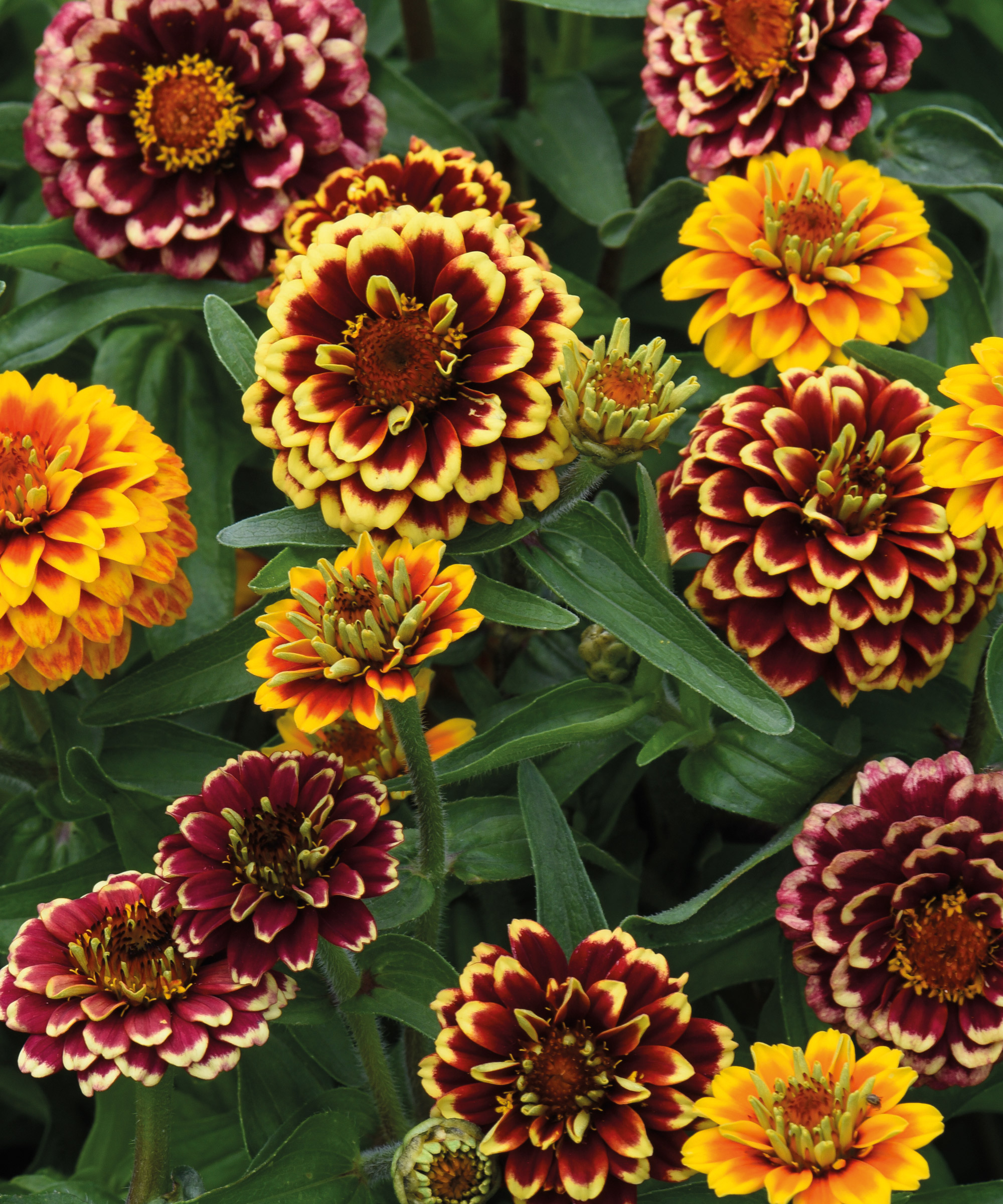
Zinnia ‘Aztec Sunset Improved’
- Hardiness: USDA 2-11 (UK H2)
- Height: 12-15in (30-40cm)
- Best for: sunny borders
These types of zinnia are a quick way to add summer sizzle to all kinds of low maintenance flowerbed ideas with their double and semi-double blooms on compact plants. ‘Aztec Sunset Improved’ is a bushy blend of ruby, copper, purple, gold and yellow to add a rich palette to your plot.
While they work beautifully as a standalone display, these zinnia varieties are also lovely planted in combination with Ipomoea Solar Power Series and Coleus Kong Series, plus scented leaved pelargoniums. Grown in full sun, they may also self-sow if not deadheaded.
14. Zinnia ‘Starbright Mixed’
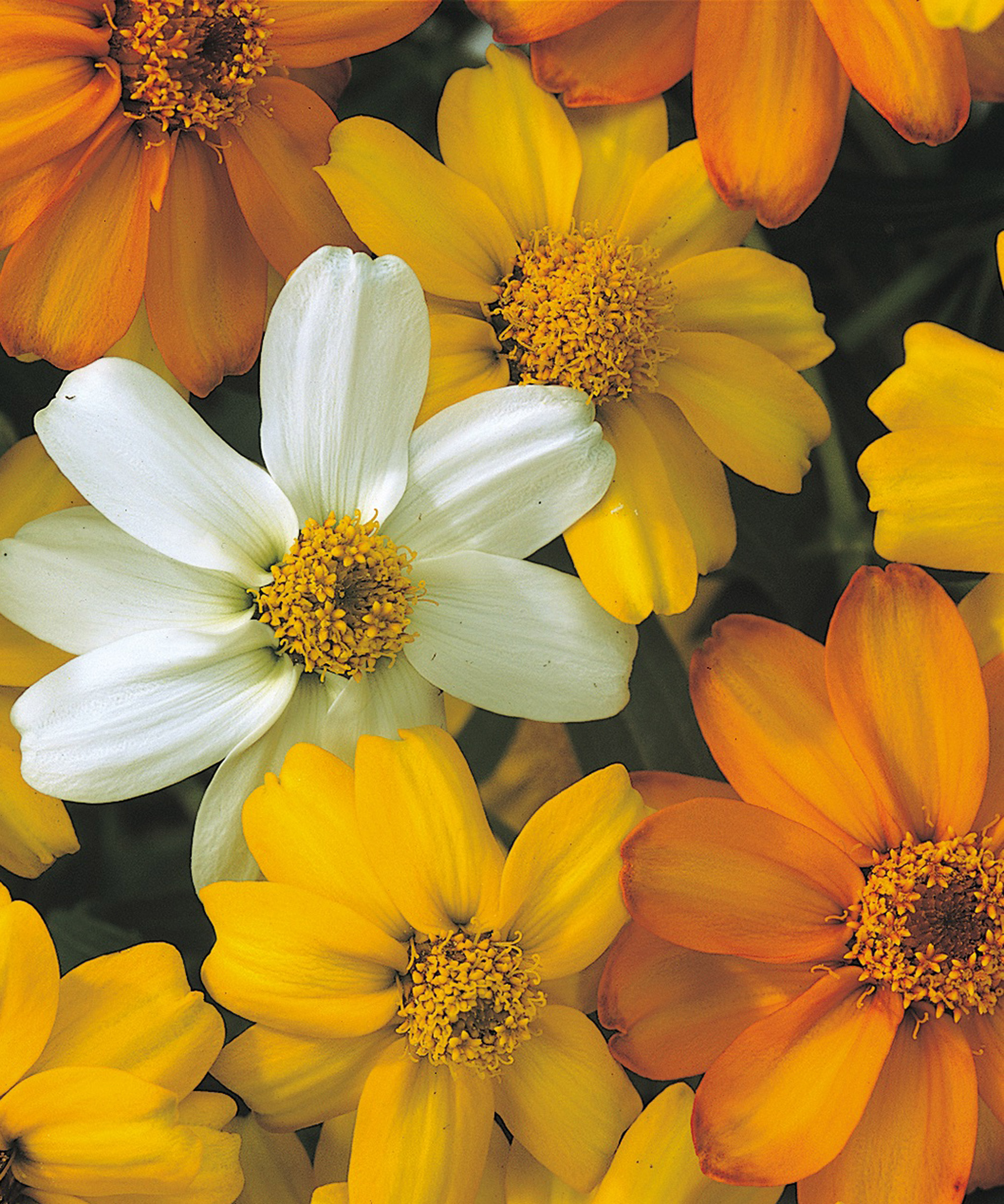
Zinnia ‘Starbright Mixed’
- Hardiness: USDA 2-11 (UK H2)
- Height: 12-18in (30-45cm)
- Best for: drought tolerance
Dainty and vibrant, ‘Starbright Mixed’ are not just pleasing to look at but also effective mildew-tolerant types of zinnia. They are also some of the best drought-tolerant plants you can grow. They flower early on young plants and bloom for months in full sun with good drainage.
They liven up borders with their citrusy shades of orange, yellow and white and bicolors, with 2in (5cm) flowers on short plants with neat and slender foliage. As well as working on their own, they look brilliant with Helichrysum petiolare, Salvia ‘Victoria’ and Senecio ‘Angel Wings’.
15. Zinnia ‘Zahara Mixed’
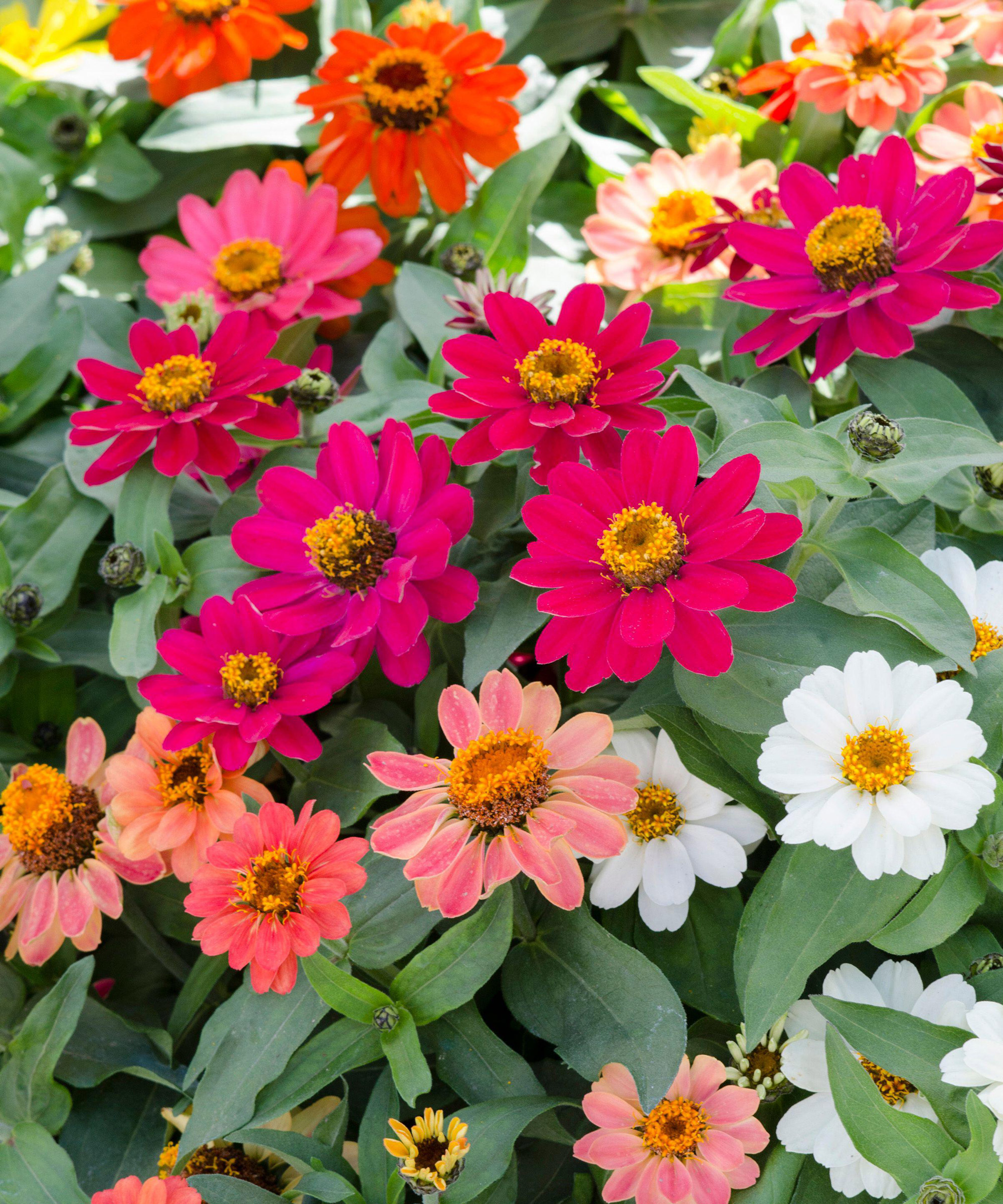
Zinnia ‘Zahara Mixed’
- Hardiness: USDA 2-11 (UK H2)
- Height: 12-18in (30-45cm)
- Best for: gravel pathways
‘Zahara Mixed’ plants are some of the most vibrant types of zinnias you can plant as edging. Available as a mix or as separate colors, they develop rich, lively displays that dazzle along a sunny gravel path in front of taller annuals or perennials.
With seven cheerful shades of pink, orange, yellow, white and bicolor, separate colors are great in containers. If you grow marigolds, these zinnia varieties work well with Tagetes ‘Crackerjack’ (African marigold), plus Agastache ‘Kudos Coral’ and Alstroemeria ‘Indian Summer’.
16. Zinnia ‘Old Mexico’ AGM
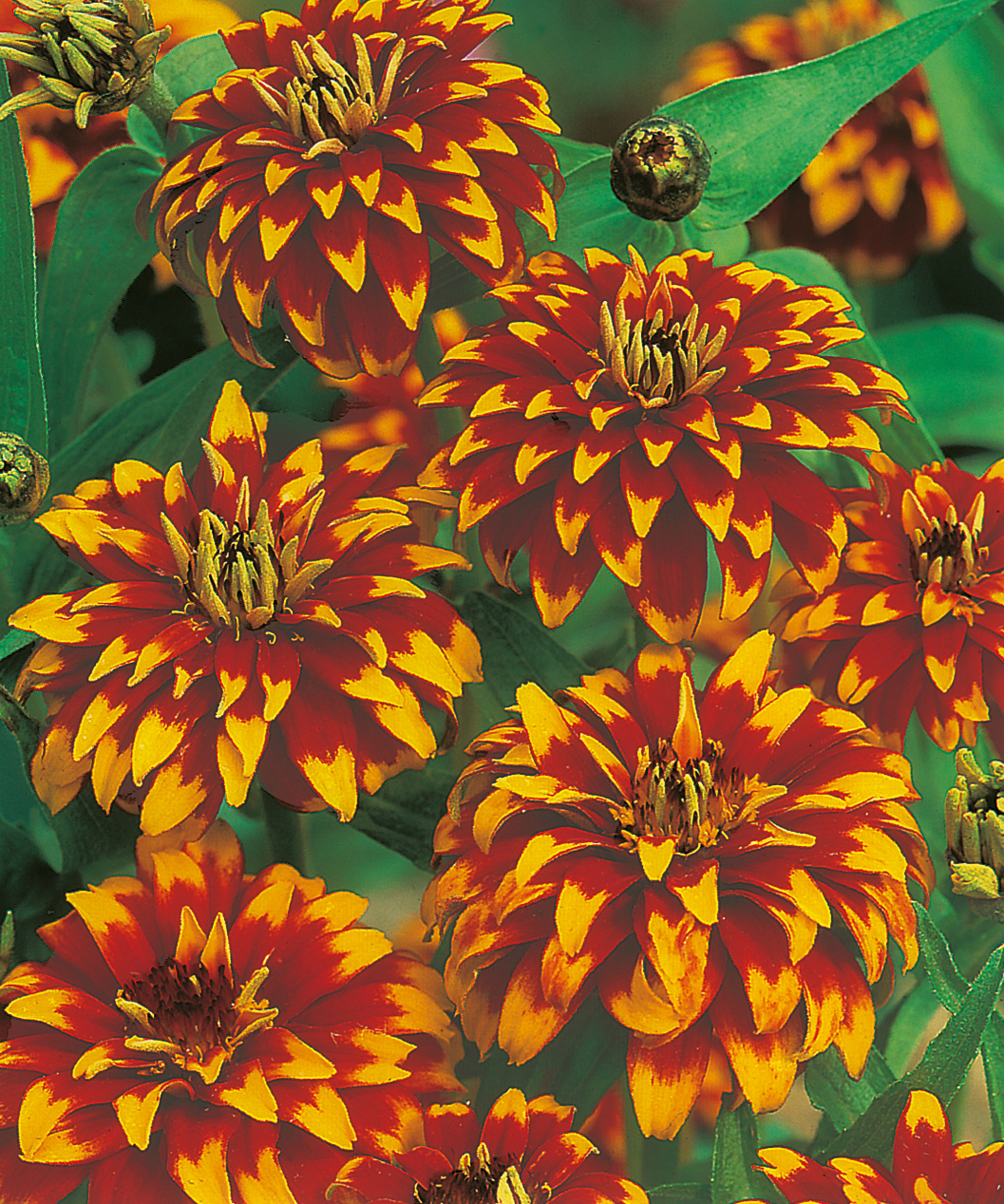
Zinnia ‘Old Mexico’
- Hardiness: USDA 2-11 (UK H2)
- Height: 12-18in (30-45cm)
- Best for: weed smothering
Many types of zinnia pack a punch with a profusion of gold blooms, and ‘Old Mexico’ is amongst the most impactful. This cheerful blend of 2in (5cm) double and semi-double flowers comes in a harmonious range of bronze, orange, gold and yellow bicolored shades with mahogany details.
For those who love growing cosmos, these zinnia varieties make a dynamic pairing with Cosmos ‘Xanthos’ as well as Canna ‘Tropicanna’ and Dahlia ‘David Howard’. The bushy plants enjoy plenty of sun and fill out into a weed-smothering mound of color in front of taller blooms.
Planting ideas for different types of zinnia
With such a startling zinnia variety to play with, it’s worth giving some thought to existing plant combinations in your beds and borders – and any extras you might like to add. Would you like a display based more around garden color schemes, structural diversity or mixed heights? Follow our quick guide to some of the key partners that can work with different types of zinnia:
- Maximize color blends or contrasts: Shades of the same color create a blanket of show-stopping tone, while neon variations give depth. So try some shasta daisies with ‘Pop Art’ zinnias, rudbeckia (black-eyed Susan) with ‘Old Mexico’, bee-friendly plants like bee balm (monarda) with ‘Purple Prince’, and peachy phlox with ‘Double Zahara Salmon Rose’. Or try unexpected color combinations in zinnias and planting partners: pinks and oranges, limes and purples, blacks with reds, silvers and yellows.
- Make the most of height: Work with different plant levels (and garden levels) in borders. Partner dwarf types of zinnia like ‘Dreamland’ and ‘Orange Star’ with majestic sweeps of taller echinacea, cosmos, aquilegia, hibiscus, lavender or verbenium, globe artichokes and giant alliums framing backs of borders. Or scatter periwinkle, dwarf sea holly (eryngium), pincushion plants (scabiosa) and violas around taller types of zinnia such as ‘California Giant’ or ‘Benary’s Giant’ Series.
- Play with mixed textures: Daisy-like ‘Profusion’ and ‘Starbright’ zinnias work well alongside tight florals like dahlias, chrysanths and ranunculus. Combine double and semi-double zinnia varieties like ‘Envy’ and ‘Oklahoma Series’ with the looser petals of erigeron and coreopsis. Also play with textural contrasts found in ornamental grasses like Stipa tenuissima, foamy goats beard (astilbe) or fluffy queen of the prairie, plume poppy, variegated hostas, spiky cordyline and pebbled lupins. Or try landscaping with hydrangeas to offset jewel-like zinnias with fatter flower shapes. Also blend large-petalled ‘Zahara’ types of zinnia with more delicate and dainty ice plants and alyssum.
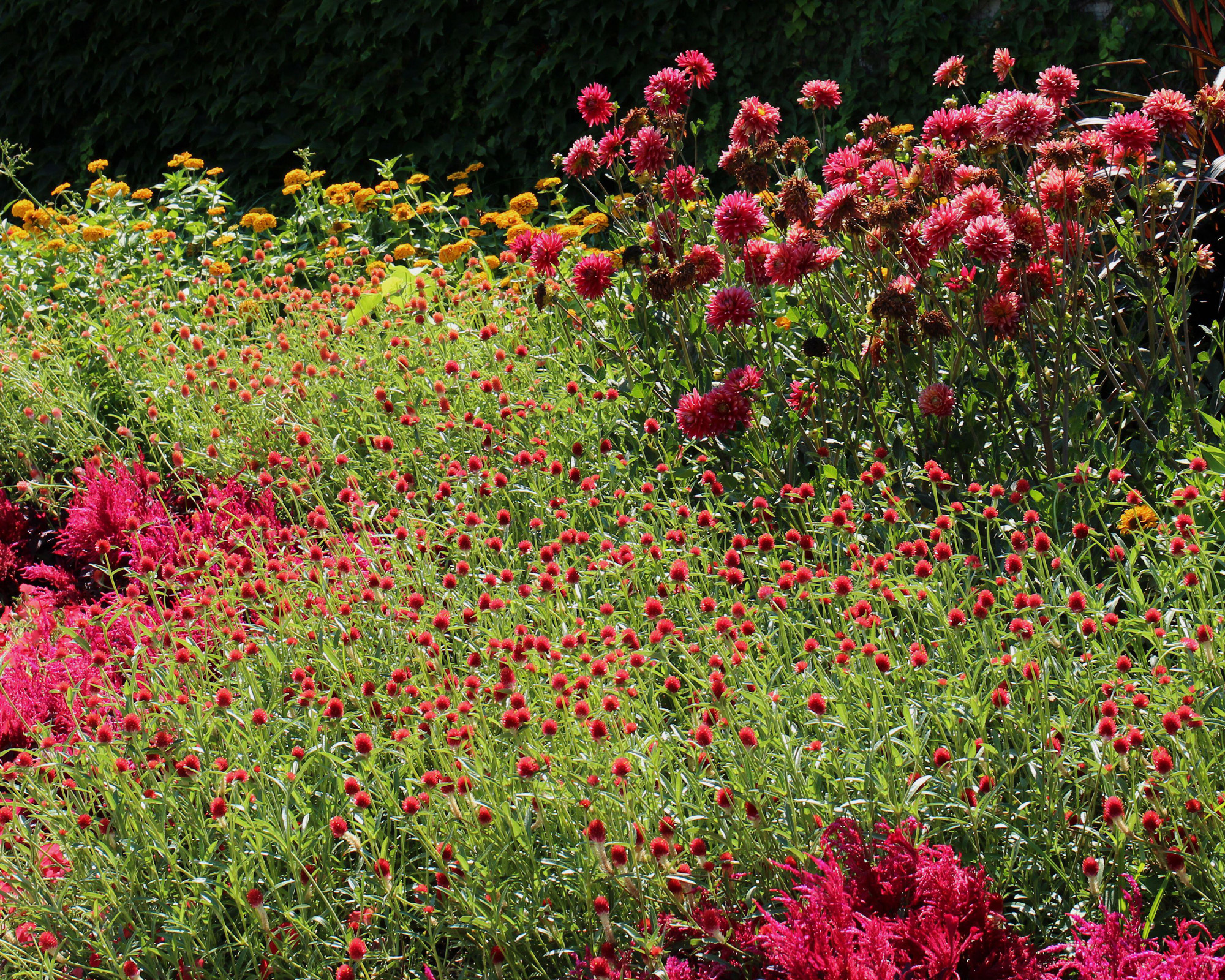
Striking planting designs for zinnias include a mix of heights and colors with flowers like strawflower, astilbe and dahlias

Graham Rice is a garden writer who has won awards for his work online, and in books and magazines, on both sides of the Atlantic. He is a member of a number of Royal Horticultural Society committees and the recipient of the 2021 Garden Media Guild Lifetime Achievement Award.
